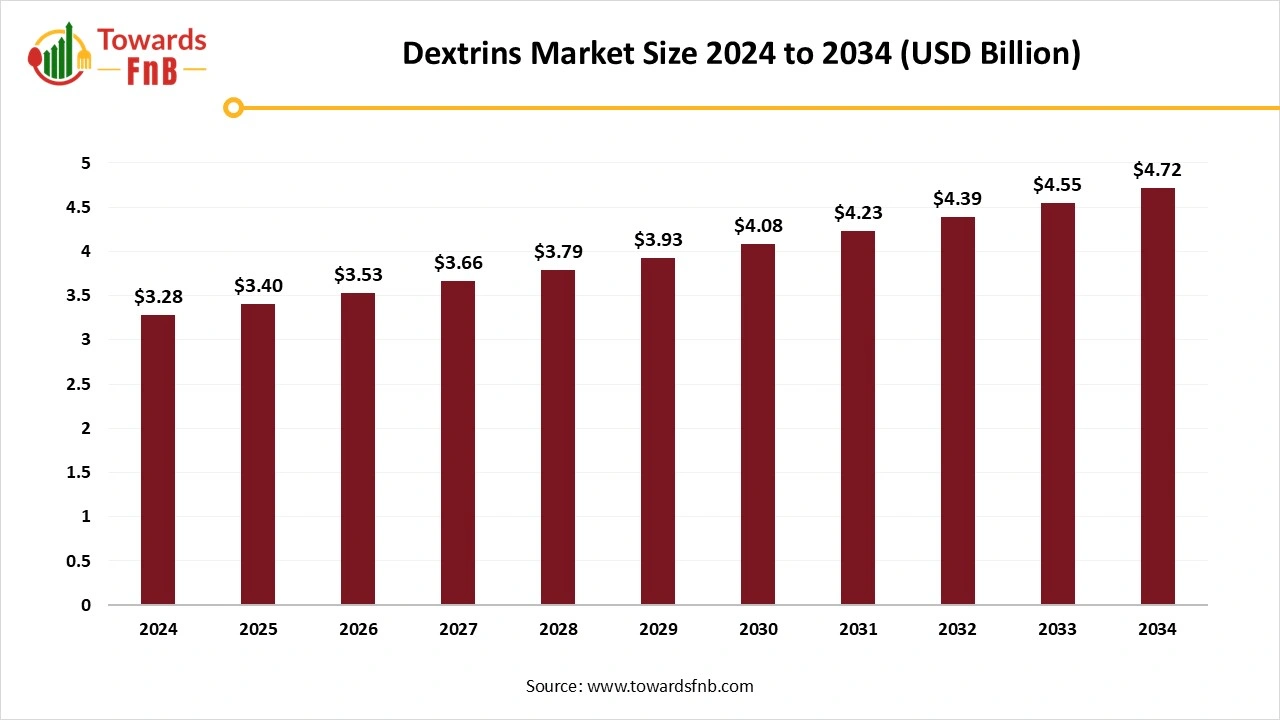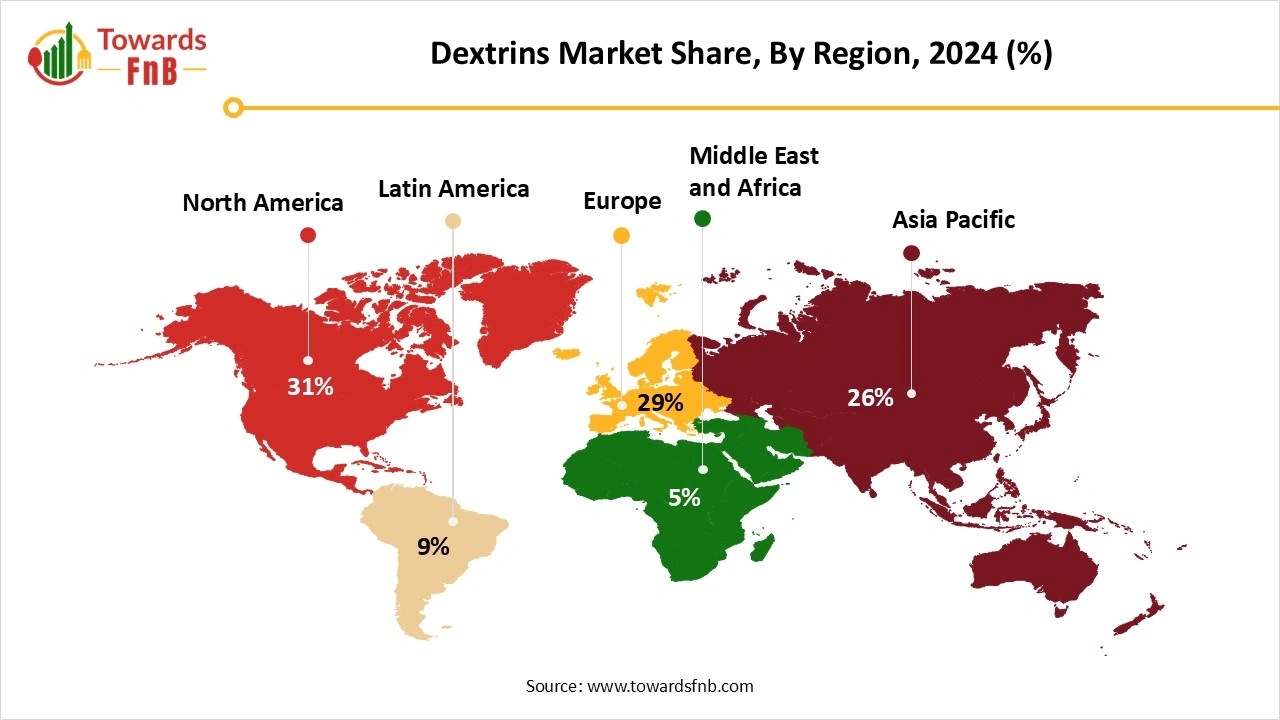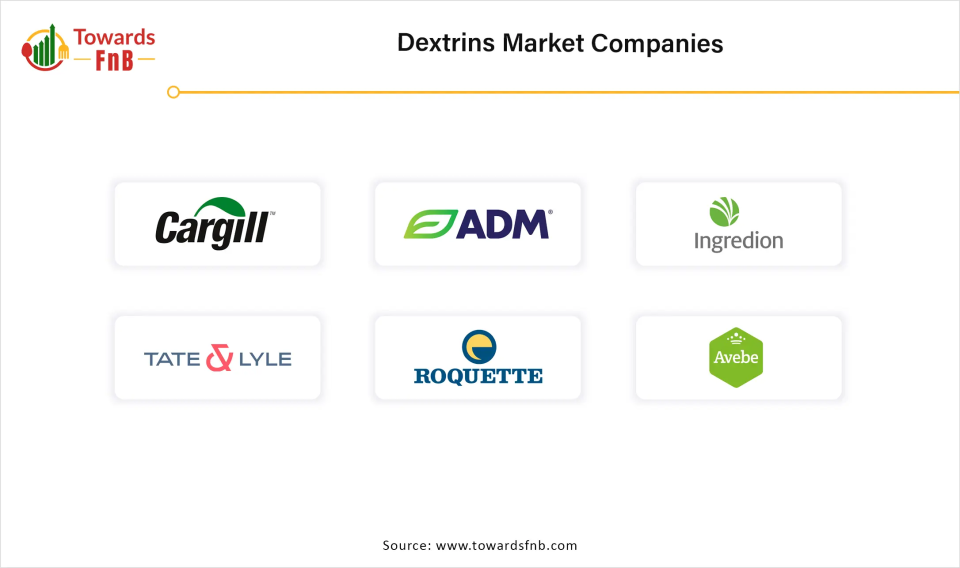November 2025
The global dextrins market size was valued at USD 3.28 billion in 2024 and is expected to grow steadily from USD 3.40 billion in 2025 to reach nearly USD 4.72 billion by 2034, with a CAGR of 3.7% during the forecast period from 2025 to 2034. The market is driven by the growing demand for improved texture and enhanced stability of products.

| Study Coverage | Details |
| Growth Rate from 2025 to 2034 | CAGR of 3.7% |
| Market Size in 2025 | USD 3.40 Billion |
| Market Size in 2026 | USD 3.53 Billion |
| Market Size by 2034 | USD 4.72 Billion |
| Largest Market | North America |
| Base Year | 2024 |
| Forecast Period | 2025 to 2034 |
| Regions Covered | North America, Europe, Asia-Pacific, Latin America, and Middle East & Africa |
Dextrins low-molecular-weight carbohydrates group made by the hydrolysis of glycogen or starch. They are primarily used as water-soluble adhesives, thickeners, binders, and fiber supplements. Commonly derived from corn, tapioca, wheat, rice, and potato starches, dextrins play a vital role in the food & beverage, pharmaceutical, textile, and industrial sectors. Their functionality varies based on the degree of polymerization, source, and processing method (e.g., roasting, enzymatic conversion).
The future of the market is promising, driven by the rising demand for foods and beverages with high nutritional content. Numerous research studies have demonstrated dextrins with several health benefits. Dextrins can promote a balanced intestinal microbiome, improving gut health. They exhibit better tolerance in the human body and do not cause any digestive discomfort. They can also regulate blood glucose and lipid metabolism, proving to be a boon for patients with diabetes, obesity, and other related complications. Moreover, dextrins enhance satiety, providing a feeling of fullness and reducing the chances of overeating. Moreover, growing research activities focus on studying the role of dextrins for extended applications.
Maintaining the high-purity of dextrin is difficult due to cross-contamination during manufacturing. Producing organic dextrins is more expensive due to the higher cost of raw materials. Purity and cost issues pose significant challenges for global manufacturers of dextrin. This ultimately hampers the supply chain and widespread distribution across different geographical locations, restricting the dextrins market.
North America Dominated the Global Market in 2024.
The demand for dextrin is booming due to the need for healthier and more convenient foods. The burgeoning e-commerce sector in North America necessitates manufacturers to use stabilizers to enhance the shelf life of products. Consumers are increasingly using organic products due to health concerns and environmental awareness. This leads to the development of organic dextrins. The sedentary lifestyles of people in North American countries, like the U.S. and Canada, have potentiated the demand for frozen foods. All these aspects positively influence market growth in North America.

What is the Contribution of the U.S. to the Global Dextrins Market?
The rising production of industrial starch in the U.S. is the major growth factor of the market. According to the U.S. Grains Council, there are 28 industrial starch plants in the U.S. In 2024, the sales of organic food were $65.4 billion, and those of non-organic food were $6.2 billion. Additionally, sales of frozen food in the U.S. are increasing, accounting for $84.4 billion from June 2023 to June 2024. (Source: https://affi.org/frozen-food-sales-are-in-the-black-4-factors-driving-growth/)
Asia Pacific Expects the Fastest Growth in the Market During the Forecast Period.
The presence of a suitable agricultural infrastructure facilitates the production of corn, wheat, rice, and potatoes. Countries like China, India, and South Korea have favorable manufacturing infrastructure, enabling large-scale manufacturing of dextrins. They are also the largest supplier of dextrin and its raw materials globally. The increasing awareness about nutritional and organic food also potentiates the use of dextrins. Rapid urbanization, sedentary lifestyles, and an increasing geriatric population lead to the use of natural products and prebiotics.
What is the Role of India in the Dextrins Market?
India exports a huge amount of corn starch and potato starch to other countries. According to World Bank data, India exported approximately 584,826,000Kg of corn starch worth $255,302.48K in 2023. The major imports were to Malaysia, Indonesia, Vietnam, Thailand, and the Republic of Korea. (Source: WITS-worldbank)
Which Type Segment Dominated the Dextrins Market?
The white dextrin segment held a dominant presence in the market in 2024. This segment dominated due to its cost-effectiveness and the ability to enhance product stability. White dextrins are predominantly used for their adhesive and binding properties. They are also used as crispness enhancers during food processing. The growing demand for fried foods, snacks, and baked foods potentiates the need for white dextrin. Moreover, they are easily water soluble and have high-strength film properties.
The Maltodextrin Segment is Expected to Grow at the Fastest CAGR in the Market During the Forecast Period.
Maltodextrin is used as a preservative, thickening agent, or to improve the flavor and texture of processed foods and beverages. It is highly preferred as it can be easily digested and absorbed in the small intestine, providing quick energy. Due to its advantages, maltodextrin is commonly incorporated in sports drinks and energy products. The increasing health awareness and physical exercise among individuals lead to the development of energy food products. It is estimated that there are 184 gym members globally.
Why did the Corn Segment Dominate the Dextrins Market?
The corn segment contributed the biggest revenue share of the market in 2024. The increasing production of corn globally and the growing demand for corn starch boost the segment’s growth. According to the International Production Assessment Division (IPAD), 1,265,982 (1000 MT) of corn was produced as of June 2025 globally. This results in easy availability of corn starch, making it a suitable choice for manufacturing dextrin. Dextrins derived from corn are high in fiber and low in calories and sugar, thereby providing nutritional value to the food.
The Potato Segment is Expected to Grow with the Highest CAGR in the Market During the Studied Years.
The rising potato production promotes the development of dextrin from potato starch. In 2023, the total potato production was approximately 383 million metric tons. Potato dextrins act as prebiotics that lead to modifications in the distal intestine, supporting intestinal health. People suffering from digestive issues mainly prefer dextrin derived from potato starch.
How the Thickening Agent Segment Dominated the Dextrins Market?
The thickening agent segment held the largest revenue share of the market in 2024. This segment dominated due to the need for improved consistency of food and beverages. Thickening agents in food and drinks are essential additives to enhance the texture and stability. The growing demand for satisfying and unique drink experiences grows, understanding the importance of various thickeners. Thickening agents stabilize the product and enhance the shelf life of food and beverages.
The Fiber Supplement Segment is Expected to Expand Rapidly in the Market in the Coming Years.
The increasing number of people with digestive issues and poor gut health augments the segment’s growth. Approximately 60 to 70 million people are affected by digestive diseases in the U.S. Government organizations launch initiatives to create awareness among the general public to deal with dietary fiber deficiency. Dextrin is prescribed by nutritionists and dieticians to supplement dietary fiber.
Which Application Segment Dominated the Dextrins Market?
The food and beverages segment led the global market in 2024. The segmental growth is attributed to the burgeoning food and beverages sector and the growing demand for stabilizers. The increasing population, rising disposable income, demand for safer products, and shifting consumer preferences foster the segment’s growth. The increasing preference for frozen food also leads to the use of dextrins. All these factors encourage manufacturers to develop innovative food products based on consumers’ demands.
The Bakery & Confectionery Segment Expects the Fastest Growth in the Market During the Forecast Period.
The growing demand for convenient and indulgent foods leads to the increasing development of bakery and confectionery products. Dextrins act as thickening agents, stabilizers, and binders in bakery items, thereby improving their texture. The infant nutrition segment is expected to grow rapidly as a sub-segment. The rising cases of malnutrition and the growing emphasis on infant nutrition to improve children’s health and growth contribute to the segment’s growth. Dextrins serve as a vital source of carbohydrates in infant nutrition, providing energy.
What Made Dry Powder the Dominant Segment in the Dextrins Market?
The dry powder segment registered its dominance over the global market in 2024. The demand for dry powder is increasing due to its high stability and easy transportation. Dextrin is available as white, yellow, or brown powders, which are partially or fully soluble in water. Dry powders are lightweight and can be transported from one place to another. They are comparatively cost-effective and can be handled easily. The powder form of dextrins is widely used for industrial applications.
The liquid/syrup segment is expected to show the fastest growth in the upcoming period. Dextrin liquids or syrups are ready-made formulations available in the market. They do not require a specialized work-up of dissolving powder in water. They are widely used to treat blood sugar in diabetics. They also act as an excellent source of soluble fiber, aiding weight management.
Why did the Food & Beverage Segment Dominate the Dextrins Market?
The food & beverage segment held a major revenue share of the market in 2024. This segment dominated because of the growing demand for food products with improved texture and high stability. The increasing competitiveness in the field necessitates key players to serve high-quality food & beverages at affordable rates, promoting the use of dextrins. Dextrins are generally cost-effective due to their low production cost and wide range of applications. Thus, the use of dextrins is essential in the food & beverage sector, impacting children’s nutrition.
The Agriculture Segment is Expected to Witness the Fastest Growth in the Market Over the Forecast Period.
Dextrin has widespread applications in agriculture, such as seed coating, slow delivery of urea, and a source of phosphorus in agricultural fields. The availability of biodegradable dextrin makes it a suitable choice in the agricultural sector. The growing need for enhanced plant productivity encourages farmers to use dextrin-based fertilizers. Numerous government organizations globally promote sustainable agricultural practices, potentiating the use of dextrins.
Which Distribution Channel Segment Dominated the Dextrins Market?
The direct sales (B2B) segment accounted for the largest share of the market in 2024. Dextrins are widely preferred by the HORECA industries for their food & beverage products. Hence, they are directly distributed by manufacturers, wholesalers, or distributors to the major food giants. Dextrins are also distributed to major giants in the fields of pharmaceuticals, agriculture, and paper due to their diverse applications. This enables companies to purchase suitable dextrin products at reasonable prices.
The Online Retail Segment is Expected to Demonstrate the Fastest Growth in the Upcoming Years.
The burgeoning e-commerce sector and the increasing adoption of smartphones propel the segment’s growth. Advancements in connectivity technology encourage people to prefer online retail. Dextrins are purchased online as a nutritional supplement, as gum for paper packaging, and as starch in food & beverages. Online retail of dextrins offers superior advantages, such as discounted offers, delivery tracking, and same-day home delivery services.
PURE Sports Nutrition
Voyager Craft Malt & Cryer Malt

By Type
By Source
By Function
By Application
By Form
By End Use
By Distribution Channel
By Region
The global fermentation enzymes market is projected to climb from USD 7.39 billion in 2025 to USD 15.02 billion by 2034, recording a CAGR of 8.2% duri...
The global resistant dextrin market size is projected to witness strong growth from USD 0.45 billion in 2025 to USD 0.92 billion by 2034, reflecting a...
The global duck meat market size is rising from USD 3.40 billion in 2025 to USD 5.89 billion by 2034. This projected expansion reflects a compound ann...
The global protein hydrolysate market size is projected to expand from USD 3.76 billion in 2025 to USD 6.27 billion by 2034, growing at a CAGR of 5.85...
November 2025
November 2025
November 2025
November 2025